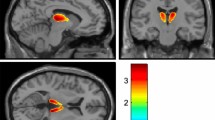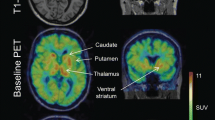Summary
Positron emission tomography (PET) following intravenous administration of β-[11 C]-L-DOPA provides a method of assessing regional cerebral uptake and utilization of levodopa. Cerebral levodopa kinetics in the rhesus monkey were investigated after the inhibition of catechol-O-methyltransferase (COMT) with RO 40-7592, and after coadministration of the peripheral aromatic L-amino acid decarboxylase (AADC) inhibitors benserazide and carbidopa. Pretreatment with RO 40-7592 (10 mg/kg), benserazide (10 mg/kg) or carbidopa (3.5 mg/kg) did not change striatal k3, which mainly reflects the ability for the brain tissue to convert [11C]-L-DOPA to [11C]-dopamine, although the brain's uptake of radioactivity increased substantially after pretreatment with the AADC inhibitors. When benserazide was coadministered with RO 40-7592 (10 mg/kg) a dose-dependent decrease in striatal k3 was measured with an apparent ED50 of 3 mg/kg. No such effect was indicated after pretreatment with the combination of RO 40-7592 (10 mg/kg) and carbidopa (3.5 mg/kg). The possible negative interactions of coadministration with COMT inhibitors and predominantly peripherally acting AADC inhibitors must be considered when used in the therapy of Parkinson's disease.
Similar content being viewed by others
References
Axelrod J (1966) Methylation reactions in the formation and metabolism of catecholamines and the effects of drugs. Prog Brain Res 18: 95–113
Bjurling P, Watanabe Y, Oka S, Nagasawa T, Yamada H, Långström B (1990) Multienzymatic synthesis of β-11 C-labelled L-Tyrosine and L-DOPA. Acta Chem Scand 44: 183–188
Borgulya J, Bruderer H, Bernauer K, Zürcher G, Da Prada M (1989) Catechol-O-methyltransferase-inhibiting pyrocatechol derivatives: synthesis and structure-activity studies. Helv Chim Acta 72: 952–969
Guldberg HC, Marsden CA (1975) Catechol-O-methyl-transferase: pharmacological aspects and physiological role. Pharmacol Rev 27: 135–206
Hagan RM, Raxworthy MJ, Gulliver PA (1980) Benserazide and carbidopa as substrates of catechol-O-methyltransferase: new mechanism of action in Parkinson's disease. Biochem Pharmacol 29: 3123–3126
Hartvig P, Lindner KJ, Tedroff J, Bjurling P, Hörnfeit K, Låndström B (1991a) Regional brain kinetics of [11 C]-6-fluoro-L-DOPA and [11C]-L-DOPA following COMT inhibition. A study in vivo using positron emission tomography (submitted)
Hartvig P, Ågren H, Reibring L, Tedroff J, Bjurling P, Kihlberg T, Långström B (1991b) Brain kinetics of L-[β-11C]DOPA in humans studied by positron emission tomography. J Neural Transm (in press)
Jeffery DR, Roth JA (1985) Purification and kinetic mechanism of human brain soluble catechol-O-methyl transferase. J Neurochem 44: 881–885
Lees AJ (1989) The on-off phenomenon. J Neurol Neurosurg Psychiatry [Suppl]: 29–37
Muggli D, Zürcher G, Da Prada M (1989) Inhibition of COMT by RO 40-7592, a potential drug for Parkinson's disease therapy. 12th annual meeting ENS, Turin, Italy
Nissinen E, Lindén I-B, Schultz E, Kaakola S, Männistö P, Pohto P (1988) Inhibition of catechol-O-methyl-transferase activity by two novel disubstituted catechols in the rat. Eur J Pharmacol 153: 263–269
Nutt JG (1987) On-off phenomenon: relation to levodopa pharmacokinetics and pharmacodynamics. Ann Neurol 22: 535–540
Oldendorf WH (1971) Brain uptake of radiolabelled amino acids, amines, and hexoses after arterial injection. Am J Physiol 221: 1629–1639
Pletcher A (1973) Effect on inhibitors of extracerebral decarboxylase on levodopa metabolism. Adv Neurol 3: 49–58
Tedroff J, Aquilonius S-M, Hartvig P, Bjurling P, Långström B (1991) Estimation of regional cerebral utilization of [11C]-L-3,4-dihydroxyphenyl-alanine (DOPA) in the primate by positron emission tomography (submitted)
Wade LA, Katzman R (1975) 3-O-methyldopa uptake and inhibition of L-dopa at the blood-brain barrier. Life Sci 17: 131–136
Zürcher G, Keller HH, Kettler R, Borgulya J, Bonetti EP, Eigenman R, Da Prada M (1990) RO 40-7592, a novel, very potent and orally active inhibitor of catechol-O-methyltransferase: a pharmacological study in rats. Adv Neurol 53: 497–503
Author information
Authors and Affiliations
Additional information
A contribution from the Uppsala University PET centre
Rights and permissions
About this article
Cite this article
Tedroff, J., Hartvig, P., Bjurling, P. et al. Central action of benserazide after COMT inhibition demonstrated in vivo by PET. J. Neural Transmission 85, 11–17 (1991). https://doi.org/10.1007/BF01244653
Received:
Accepted:
Issue Date:
DOI: https://doi.org/10.1007/BF01244653




